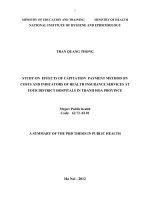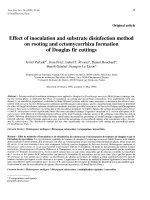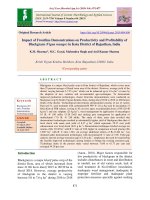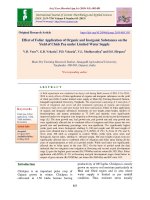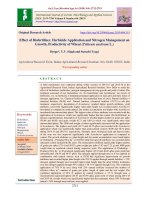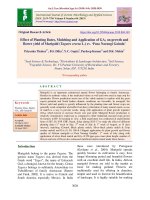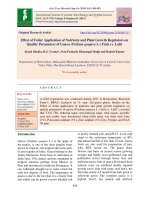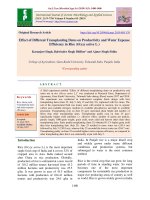Effect of nutrients application method on productivity and economics of maize
Bạn đang xem bản rút gọn của tài liệu. Xem và tải ngay bản đầy đủ của tài liệu tại đây (258.03 KB, 8 trang )
Int.J.Curr.Microbiol.App.Sci (2019) 8(5): 1443-1450
International Journal of Current Microbiology and Applied Sciences
ISSN: 2319-7706 Volume 8 Number 05 (2019)
Journal homepage:
Original Research Article
/>
Effect of Nutrients Application Method on Productivity
and Economics of Maize
Rama Kant Singh1*, Pankaj Kumar1, S.K. Singh1, Ajit Kumar Singh2 and S.B. Singh3
1
2
Krishi Vigyan Kendra, Katihar
Department of Agriculture Economics, SMMTD College, Ballia
3
Krishi Vigyan Kendra, Gya
(Bihar Agricultural University, Sabour, Bhagalpur), India
*Corresponding author
ABSTRACT
Keywords
Growth and yield
attributes, Maize,
Nutrient application
method, Zinc
Article Info
Accepted:
12 April 2019
Available Online:
10 May 2019
The concept of balanced fertilization with proper method at proper time paves the way for
optimum profitability of farmers. Since most of the soils in Koshi region of Bihar are
sandy clay in their textural class with medium to low in N, P, K and Zn. Due to that
farmers of Koshi region applying nutrients unscientifically. Therefore, they enable to reap
best harvest and to augment the profitability from this crop and hence an experiment was
conducted at farmer fields of Katihar district by Krishi Vigyan Kendra, Katihar, (Bihar
Agricultural University Sabour, Bhagalpur) during two consecutive years of 2015-16 and
2016-17 to study the effect of nutrients application method on productivity and economics
of maize. The experiment was laid out in alluvial soil with three treatments and ten
replications in RBD. The details of treatments was {(T1–Farmer Practices (60:0: 0:: N:P:K
Basal + 50:40:20 N:P:K at 30 DAS+ 30 kg N at 60 DAS), T 2–RDF (60:60:40:: N:P:K
Basal + 45 kg N at 30 DAS+45 kg N at 60 DAS), T3– RDF (60:60:40:25:: N:P:K:Zn Basal
+ 45 kg N at 30 DAS + 45 kg N at 60 DAS)}. Healthy and bold seeds of maize var.
Pioneer 3522 were dibbled into the soil @ 1 seed hill-1 at a spacing of 60 cm X 20 cm. The
growth and yield attributes of maize viz., plant height, plant diameter, leaf length, leaf
width, cob length, no of cob per plant, no of grains per cob, kernel and stover yield were
significantly influenced by different method of nutrient application. There was a
progressive increase in the growth and yield attributes with each application methods of
nutrients applied from T 1 to T2 and further increase in growth attributes were noticed when
the graded levels fertility were supplemented with Zn as soil application T 3. There was a
gradual and progressive increase in growth and yield attributes with basal application of P
K and zinc in comparison to T1 where P K applied at 30 days after sowing.
Introduction
Maize is an important cereal in India, and
both its area and production has been steadily
increased over the past two decades. In India,
the major maize growing season is kharif
which accounts for about 85% of the total
maize area. However, in spite of maximum
1443
Int.J.Curr.Microbiol.App.Sci (2019) 8(5): 1443-1450
share in area, the relative contribution of
kharif maize is comparatively much lower
than rabi maize. Rabi maize contributes more
than 25% to annual production with less than
10% of total maize growing area. Several
factors have been found to affect the
productivity of rabi maize however; fertilizer
management is one of the chief factors that
affect the growth and yield of maize.
Maize is an exhaustive crop which requires
adequate amounts of macro and micro
nutrients in order to get better growth and
exploit yield potential. Winter maize was
proved to be more responsive to the fertilizer
application (Savita Mehta et al., 2011) due to
its vigorous plant growth and longer duration.
NPK are critical input in agriculture and its
importance on account of the vital role being
played in major life processes and its
availability to the growing crop in required
levels is of very important. Among the micro
nutrients, zinc is now been reported as the
fourth most important limiting nutrient
element in the crop production after N, P and
K. Under Zn deficiency conditions, flowering
and yields are reduced and growth period is
prolonged resulting in delayed maturity and
quality of the crop may also suffer. Since
most of the soils in Koshi region of Bihar are
sandy clay in their textural class with medium
to low in N, P and K the nutrient requirement
of this crop, especially with respect to the
major nutrients needs to be scientifically
quantified in proper time but farmers of Koshi
region not applied as a basal dose of nutrients
specially P, K and Zn.
Therefore, they enable to reap best harvest
and to augment the profitability from this crop
and hence the present investigation was
conducted by Krishi Vigyan Kendra, Katihar
to study the effect of nutrients application
method on productivity and economics of
maize.
Materials and Methods
The experiment was conducted at farmer
fields of Katihar district by Krishi Vigyan
Kendra,
Katihar,
(Bihar
Agricultural
University Sabour, Bhagalpur) during two
consecutive years of 2015-16 and 2016-17 to
study the effect of nutrients application
method on productivity and economics of
maize. It lies between Latitude 25’N to 26’N,
Longitude 87’ to 88’E with an altitude of 32
m above MSL. The climate is sub-tropical
and humid having mean maximum and
minimum temperature between 420C and 40C,
respectively and the average annual rainfall of
the district is about 1200 mm. The
experimental soils are non-calcareous light
gray flood plain belongs to the Alluvial Tract
lies between three major rivers Mahananda,
Kosi and Ganga. The soil samples were
collected from different farmer field before
start the experiment and after harvesting of
the crop in each year and at each sampling
site and analyzed with standard method.
The experiment was laid out in RBD with
three treatments and ten replications in 4.0 m
Χ 2.5 m plot size with treatments was {(T1–
Farmer Practices (60:0: 0:: N:P:K Basal +
50:40:20 N:P:K at 30 DAS+ 30 kg N at 60
DAS), T2–RDF (Basal 60:60:40:: N:P:K + 45
kg N at 30 DAS+45 kg N at 60 DAS), T3–
RDF (Basal 60:60:40:25:: N:P:K:Zn + 45 kg
N at 30 DAS + 45 kg N at 60 DAS)}
respectively. Healthy and bold seeds of maize
var. Pioneer 3522 were dibbled into the soil
@ 1 seeds hill-1 at a spacing of 60 cm X 20
cm i.e. plants density was 8300 plants ha-1.
The crop was harvested at maturity when the
cobs dried and the entire plants turned yellow
and analyzed standard statistical analysis of
variance technique. The B C ratio and other
calculation done as follows:
Harvest index = Economic yield (seed yield)
Biological yield (seed + stover yields)
1444
Int.J.Curr.Microbiol.App.Sci (2019) 8(5): 1443-1450
Nutrient uptake by grain (kg ha-1) =
respectively. It is possible due to reduced loss
of nutrients from Indiscriminant doses of
nutrients. Similar findings were also
supported by Singh et al., (1995) and
Chandrasekhar (2000) (Fig. 1).
Nutrient content (%) X Kernel yield (kg ha-1)
100
Nutrient uptake by stover (kg ha-1) =
Effect of different treatments on yield
parameters of maize
Nutrient content (%) X Stover yield (kg ha-1)
100
Net returns = Gross returns
operational cost (Rs. ha-1)
–
Total
B:C Ratio = Net returns (Rs.ha-1)
Cost of cultivation (Rs.ha-1)
Results and Discussion
Effect of treatments on growth attributes
of maize
The growth parameters of maize viz., plant
height, plant diameter, length and width of
leaves gradually increased with the
advancement in the growth intervals of the
crop till the final stage under all treatments.
The rate of increase in plant height was most
rapid during 30 to 60 DAS. The full height
was attained by the plants at 90 DAS and
thereafter the plant height was almost ceased
or decreased at harvest. Plant growth
attributes significantly affected by various
treatments at all the growth intervals of
maize. Plant height, plant diameter, leaf
length and leaf width were at harvesting stage
maximum (184.25 cm, 14.72 cm, 74.65 cm
and 11.21 cm) under T3– RDF (Basal
60:60:40:25:: N:P:K:Zn + 45 kg N at 30 DAS
+ 45 kg N at 60 DAS) which was significantly
superior (182.64, 12.45, 74.28 and 10.73 cm)
over T2–RDF (Basal 60:60:40:: N:P:K + 45
kg N at 30 DAS+45 kg N at 60 DAS), While
minimum (160.30, 11.34, 68.52 and 10.27
cm) growth attributes were recorded under
T1– where 60:0: 0:: N:P:K Basal + 50:40:20
N:P:K at 30 DAS+ 30 kg N at 60 DAS,
The significant increase in yield attributes
were observed under the application of
different treatments viz. number of cob per
plant, cob weight (g), cob length, cob girth
and number of grain row per cob (Table 3 and
4). This might be due to the sufficient amount
of nutrient availability for the better growth
and development of the plant which
ultimately resulted in the higher yield
attributes. Secondly the increase yield
attributing characters might be due to rapid
mineralization of N from organics which
might have met the N requirement of the crop
at critical stages. Organic act as nutrient
reservoir and upon decomposition produce
organic acid, thereby absorbed ion were
released slowly during entire growth period
leading to higher yield attributing characters.
These findings are in agreement with those of
Kumar and Singh (1992), Rameshwar et al.,
(1998), Sheeba et al., (2000) and Kumar and
Singh (1992).
Effect of different treatments on kernel
and stover yield of maize
Enhanced levels of nutrient supply exerted a
significant and positive influence on the
kernel yield of maize (Table 3 and Fig. 2).
The kernel yield increased progressively with
apply of fertiliser with T2 (60:60:40:: N:P:K
basal + 45 kg N at 30 DAS+45 kg N at 60
DAS) 92.32 qt ha-1 and the kernel yield was
further escalated when these levels were
supplemented with Zn through soil (T3 102.34 qt ha-1 ) 60:60:40:25:: N:P:K:Zn basal
+ 45 kg N at 30 DAS + 45 kg N at 60 DAS in
1445
Int.J.Curr.Microbiol.App.Sci (2019) 8(5): 1443-1450
comparison with T1 (65.45 qt ha-1) where
nutrients supplied in unscientific manner
60:0: 0:: N:P:K as basal + 50:40:20 N:P:K at
30 DAS+ 30 kg N at 60 DAS. In the present
investigation the grain and stover yields were
significantly
more
under
highest
concentration of Zn with RDF (Table 4). As
the grain yield is positively correlated with
yield attributes, which were also higher
(Table 4 and 3) due to the more availability of
nutrients under the application of 25 kg Zn +
RDF application at critical stages, which
ultimately produced the higher yields. These
findings are in agreement with those of Singh
et al., (1981), Hussen and Reddy (1985),
Ramana et al., (2002) and Motavalli et al.,
(1993).
N at 60 DAS (0.58) which was close to T2 60:60:40:: N:P:K basal + 45 kg N at 30
DAS+45 kg N at 60 DAS (0.56) and T1 60:0: 0:: N:P:K as basal + 50:40:20 N:P:K at
30 DAS+ 30 kg N at 60 DAS (0.52). It is
possible due to excellent growth and
development of maize plant under higher
nutrient environment during critical period of
crop growth and highly correlated with the
findings of Singh et al., (1995).
Effect on soil properties
Chemical properties of soil viz., pH, EC, OC,
and available N, P and K status were
determined before sowing and after harvest of
crop under different treatments (Table 1)
indicated that the different treatments did not
altered the various properties of soil
significantly. Since the present study
concerned with the effect of RDF an
application method with Zn on maize in
experimental field only for two season, hence
remarkable changes in soil properties was not
observed.
Harvest Index
As regarded harvest index it was not
influenced markedly due to different
treatments (Table 4). The maximum harvest
index was obtained under T3 - 60:60:40:25::
N:P:K:Zn basal + 45 kg N at 30 DAS + 45 kg
Table.1 Effect of different treatments on physico-chemical properties of experimental soil
Treatments
pH
ECe
-1
(1 : 2.5)
(d Sm )
Initial Final Initial Final
OC
N
P
K
Zn
-1
(%)
Available Nutrients (Kg ha )
Initial Final Initial
Final
Initial Final Initial
(ppm)
Final
Initial
Final
T1
6.92
6.83
0.19
0.21
0.26
0.26
189
180
22
19
235
232
0.42
0.40
T2
6.94
6.82
0.19
0.23
0.31
0.32
204
208
22
25
238
240
0.42
0.42
T3
6.95
6.88
0.21
0.30
0.33
0.35
215
224
23
27
241
248
0.45
0.48
CD (p=0.05) 0.02
0.02
NS
0.02
0.02
0.03
4.0
3.8
0.06
0.05
2.2
2.5
NS
0.2
Table.2 Effect of different treatments on uptake of different nutrients in seed and stover of maize
Treatments
N
T1
T2
T3
CD (p=0.05)
27.21
31.42
33.55
0.74
Seed (Kgha-1)
P
6.25
6.54
7.28
0.04
K
24.45
27.39
31.50
0.25
1446
N
164.74
167.36
170.22
1.04
Stover (Kgha-1)
P
52.38
57.35
61.62
0.95
K
240.51
252.25
255.30
2.08
Int.J.Curr.Microbiol.App.Sci (2019) 8(5): 1443-1450
Table.3 Effect of different treatments on growth attributes of maize
Treatment
T1
T2
T3
CD (p=0.05)
Plant
height
(cm)
160.30
182.64
184.25
1.54
Plant
diameter
(cm)
11.34
12.45
14.72
1.21
Leaf
length
(cm)
68.52
74.28
74.65
0.26
Leaf
width
(cm)
10.27
10.73
11.21
0.22
Cob
length
(cm)
14.76
16.31
16.87
0.05
Cob
grith
(cm)
11.2
14.8
16.5
0.78
No of
cob
plant-1
1.35
1.38
1.39
0.02
No of
grains
cob-1
342
365
387
4.56
Table.4 Effect of different treatments on yield attributes of maize
Treatment
T1
T2
T3
CD (p=0.05)
No of
grains
plant-1
461.70
503.70
537.93
12.61
Kernel wt
plant-1 (g)
108.04
134.99
153.31
15.85
Stove
wt.
plant1
(g)
147.24
161.45
175.63
8.24
Test wt Grain
1000
yield (qt
seeds
ha-1)
(g)
234
65.45
268
92.32
285
102.34
14.70
11.45
Stove Harvesting
yield
Index
(qt
ha-1)
125.25
0.52
165.60
0.56
175.16
0.58
9.36
0.01
Table.5 Effect of different treatments on economics of maize
Treatment
T1
T2
T3
CD (p=0.05)
Cost of cultivation
(Rs ha-1)
48206
48806
50840
44.53
Gross Income
(Rs ha-1)
123574
150650
169805
32.85
Fig.1
1447
Net Income
(Rs ha-1)
75368
101844
118965
38.50
BC
1.56
2.09
2.34
NA
Int.J.Curr.Microbiol.App.Sci (2019) 8(5): 1443-1450
Fig.2
Fig.3
Fig.4
1448
Int.J.Curr.Microbiol.App.Sci (2019) 8(5): 1443-1450
Fig.5
Total N, P and K uptake by crop
On considering the nutrients uptake in grain and
stover (Table 2, Fig. 3 & 4) maximum N, P and
K uptake in grain and stover were obtained
under T3 as compared to T2 and T1. The
increase in nutrient contents and uptake could
be attributed to increase supply of nutrients to
the plant, which in turn might have resulted in
profuse shoot and root growth thereby
activating greater absorption of N, P and K
from the soil. These results were also supported
by Prasad et al., (2010).
Effect of different treatments on economics
of maize
The economic analysis of the treatment is the
most important from the farmer’s point of view
regarding implementation of the practices
evolved under any investigation. Economic
analysis of treatment was determined on per
hectare area basis, which includes cost of
cultivation, gross monetary returns, net
monetary returns and benefit cost ratio as
affected by various treatments (Fig. 5 and Table
5). The cost of cultivation was noted minimum
under T1 and it increased orderly with different
treatments due to increase in addition of
application method with Zn. The higher gross
income were observed under T3 due to obtaining
higher grain and stover yields with these
treatments. The maximum B:C ratio was
noticed under the application of nutrients as
60:60:40:25:: N:P:K:Zn basal + 45 kg N at 30
DAS + 45 kg N at 60 DAS (2.34) thus indicate
that for achieving the maximum benefit. The
maximum benefit per rupee investment might
be due to the application of nutrients in three
split as one third N with full doses of P and K
with 25 kg Zn as compared to other treatments.
References
Aruna
M.,
Veeraraghavaiah
R.
and
Chandrasekhar K. 2006. Productivity and
quality of maize (Zea mays L) as affected
by foliar application of N and Zn at
flowering. The Andhra Agricultural
Journal. 53(1&2): 17-19.
Chandrashekar. 2000. Response of maize (Zea
mays L.) to organic manures with
inorganic fertilizers. Karnataka Journal of
Agril. Science, 13(1): 144-146
Chopra C. L. and Kanwar J. S. 1991 Analytical
Agricultural
Chemistry,
Kalyani
Publication, New Delhi.
Husssen M. and Reddy D.B. 1985. Studies on
yield response of hybrid maize to level of
N and P2O5. Indian J. Agron. 30: 384385.
Jackson M. C. 1973. Soil chemical analysis,
prentice hall of India private limited, New
Delhi, pp.498.
Kumar Anil S., Chidanandappa H.M and Babu
Vijay Sankar M. 2010. Effect of different
souces of zinc of growth, yield and uptake
of nutrient by maize crop (Zea mays L.).
Mysore Journal of Agricultural Sciences.
44 (1): 92 – 99.
1449
Int.J.Curr.Microbiol.App.Sci (2019) 8(5): 1443-1450
Kumar S. and Singh R.P. 1992. Cob
characteristic and soybean yield in maize
– legume inter cropping system,
Himachal J. of Agron. 8(1): 38-43.
Manimaran M. and Poonkodi P. 2009. Yield
and yield attributes of maize as influenced
by graded levels of phosphorous
fertilization in salt affected soils. Annals
of Agricultural research. 30(1&2): 26-28.
Motavalli P.P., Kelling K.A., Synerud T.D. and
Wolkowski R.P. 1993. Interaction of
manure fertilizers in northern crop
production. Journal of production
Agriculture, 6(2): 192-194.
Olsen S. R., Cole C. L., Watnab P.S and Dean
L. A. 1954. Estimation of available
phosphorous in soils by extraction with
sodium bicarbonates, USDA Circular No.
939.
Prasad J., Karmakar S., Kumar R. and Mishra
B. 2010 Influence of Integrated Nutrient
Management on Yield and Soil Properties
in Maize-Wheat Cropping System in an
Alfisol of Jharkhand. Journal of the
Indian Society of Soil Science, 58 (2):
200-204.
Ramana S., Biswas A.K. and Singh K.K. 2002.
Effect of distillery effluents on some
physiological
aspects
in
maize.
Bioresource Technology 84(3): 295-297
Rameshwar and Singh C.M. 1998. Nutrient
many for yield maximization in maize
(Zea mays)- Wheat system under rainfed
mid hilly condition of H.P. Himachal J. of
Agricultural Research, 24 (1-2): 11-19
Rameshwar, Singh C.M., Sharma S. and Singh
G. 2001. Crop yields and soil fertility
under different combinations of fertilizers
and FYM in maize-wheat sequence under
rainfed conditions. Journal hill research,
14(1): 26-31.
Reddy Y.V.R., Somani L.L. and Rama Krishna
Y.S. 2008. Maize production technology.
Agro Publishing Academy, Vinayaka
complex, Udaipur. P – 31-49.
Sheeba S. and Chellamuthu S. 2000. Effect of
long term application of fertilizers and
manure on soil properties and yield under
maize- cowpea-ragi rotation. Journal of
Eco-physiology 3(3): 117-121.
Singh A., Vyas A. K. and Singh A.K. 1995
Effect of Nitrogen and Zine application
on growth, yield and net return of maize.
Annual Agricultural Research, 21(2):
296-297
Singh A., Awasthi R.P., Singh R.D. and Arya
R.L. 1995. Effect of inorganic fertilizer in
maize
(Zea
Mays)
and
ginger
intercropping system in humid hilly soils.
Indian Journal of Agronomy, 40(4): 549552.
Singh D. and Singh S.M. 2006. Response of
early maturing maize (Zea mays) hybrids
to applied nutrients and plant densities
under agroclimatic conditions of Udaipur
in Rajasthan. Indian Journal of
Agricultural Sciences. 76 (6): 372 – 374.
Subbiah B.V. and Asija G.L. 1956 b. Alkaline
Permanganate Method. Current Science.
25: 255 - 260.
Tandon H.L.S. 1999. Methods of analysis of
soil, plants, waters and fertilizers.
Fertilizer Development and Consultation
Organisation, New Delhi. P- 63.
Walkley A. and Black C.A. 1934. An
examination of determining soil organic
carbon and proposed modification of the
chromic acid titration method. Soil
Science. 37: 29-34.
How to cite this article:
Rama Kant Singh, Pankaj Kumar, S.K. Singh, Ajit Kumar Singh and Singh, S.B. 2019. Effect of
Nutrients
Application
Method
on
Productivity
and
Economics
of
Maize.
Int.J.Curr.Microbiol.App.Sci. 8(05): 1443-1450. doi: />
1450
